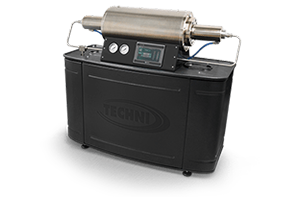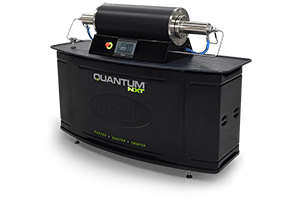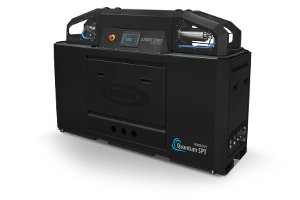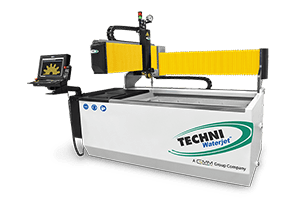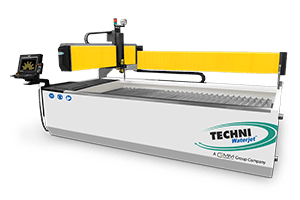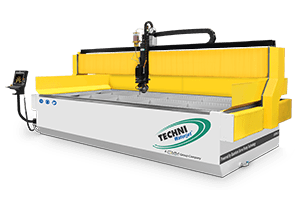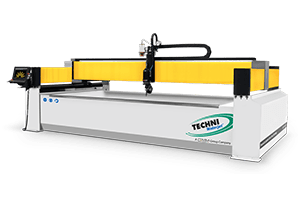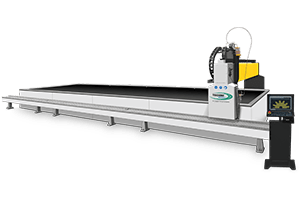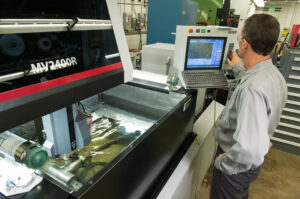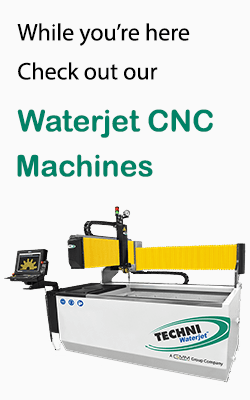The manufacturing processes we use to produce things are evolving. Focusing on methods to improve efficiency and reduce costs is a priority. Consider the methods used to produce goods from raw materials. Many options are available to cut materials like metal, aluminum, steel, titanium, plastic, rubber, and more. Waterjet cutting and high-definition plasma cutting are two of the most flexible industrial cutting technologies.
People often confuse waterjet cutting and high-definition plasma cutting technologies. But each has advantages and disadvantages.
In this article, we discuss waterjet cutting vs plasma cutting tools. What are the differences between them? The results will help you decide which tools suit your precise needs best.
So let’s dive into the two technologies and how they differ.
What is the Difference Between Waterjet and Plasma Cutting?
To understand the difference between waterjet cutting and plasma cutting, and their respective advantages, we need to understand how these two technologies work and their capabilities.
While the purpose of both cutting technologies is to cut materials, the working process used by each of the two methods is different.
Waterjet Cutting
As the name implies, a waterjet system aims a stream of water at the object to create the cut. A water jet uses very high-pressure water to produce enough destructive force for cutting. It can cut metal, steel, plastics, titanium, aluminum, and almost any material. From soft materials like paper, foam, and rubber to hard materials like granite, a water jet cutter has the ability to produce precise cuts.
For softer materials, waterjet cutting uses pure water, a process known as water-only cutting (or pure waterjet cutting). For harder materials, the cutting system mixes water with an abrasive material. Doing so increases the cutting power, and this technique is called abrasive water jet cutting.
In abrasive jet cutting, the abrasive material is added near the end of the process, at the nozzle. Therefore, an abrasive jet cutter can also work as a pure water jet cutter without abrasive materials.
Even though waterjet cutting seems innovative and futuristic, this efficient cutting technique was introduced a long time ago. Using a water jet to make cuts gained traction as early as the 1930s. Cutting paper was one of the first business applications.
The water pressure used in waterjet cutting is so high that cutting speeds can be as high as three times the speed of sound!
Importance of Waterjet Cutting
The waterjet cutting method has various advantages. One of them is that there is no direct contact between the cutting tool and the material on which it will perform the cut. This is one of the main differences compared to plasma arc cutting: it does not increase the temperature of the material during the cutting process. This makes the method ideal for cutting surfaces where temperature regulation is crucial, for example, when used to cut conductive metals.
Plasma Cutting
On the surface, plasma cutting might seem similar to water cutting, with the stream of water replaced by a high-pressure gas.
However, the science behind a gas plasma cutter is more complex, expensive, and with a different working process. A gas plasma cutter can only cut materials that naturally conduct electricity.
Instead of water, plasma cutting utilizes a gas jet with its atoms in a charged state. This method requires grounding the workpiece so it acts as the second electrode. When the charged gas falls on the material, it creates a complete electrical circuit between the nozzle and the workpiece.
The electrical circuit creates a high temperature at the point of contact. Essentially, the material will melt away at that point and lead to a precise cut. This is what results in the cutting action of plasma cutting machines. The melted metal is blown away by the high-velocity gas, creating clean cuts.
A similar technique was utilized in the welding industry, and plasma arc cutting emerged in the 1960s. This makes it a relatively newer technology as compared to waterjet cutting.
Importance of Plasma Cutting
Initially, plasma arc cutting was quite expensive and limited due to heavy and complex equipment. However, the technology is now much cheaper, available at a fraction of the original cost.
While professional CNC-enabled plasma cutting machines start from $15,000 and cost anywhere up to $300,000, hobbyists can still find handheld plasma arc cutters at a low cost of about $300.
Water Jet Cutting vs Plasma Cutting – Which is the superior technology?
When deciding the superior technology between waterjet cutting and plasma cutting, many factors need consideration. Each job has its requirements, and these requirements need to be determined.
Let us study the factors that affect the choice of superior cutting technology:
1. Upfront Costs
- There are cheaper and affordable options available for hobbyists. But a professional CNC plasma cutter with comparable cutting prowess to waterjet cutting costs between $50,000 and $100,000.
- CNC Waterjet cutters require an expensive water pump to create ultra-high water pressure. These cutters come at a higher cost, from $100,000 to as much as $350,000.
- On the purchase cost front, plasma cutting machines are the clear winners with a significant difference in initial costs.
2. Running Costs
- Plasma cutting machines have a low operating cost, which mainly includes the cost of electricity, gases, and consumables. The budget for operating costs is around $15 per hour, which offers advantages for large-scale production.
- For waterjet cutters, the operating costs depend on the cost of electricity, consumables, and abrasive material. Abrasive materials turn out to be the most expensive factor. Waterjet cutting costs about $30 per hour, with abrasives making up about 75% of the cost.
- On running costs, laser cutters offer more advantages and are more cost-effective. They also have an edge if you are using abrasive waterjet cutting.
3. Lifespan
- In plasma cutting machines, the consumables needed for each job wear out quickly every time the machine is started, in addition to the operating time for each job. Parts like the nozzle might only last a few hours.
- The consumables of waterjet cutting have a long lifespan. The nozzle can last for about 100 hours, and other parts last longer (pressure pumps last for about 10,000 hours).
- In terms of the lifespan of consumables, waterjet cutting has a cost-effective advantage over the plasma cutting machine. Less need for replacement of consumables also means a lower cost of labor.
4. Range of Materials Supported
- A plasma cutter supports cutting materials that conduct electricity, typically metals, steel, etc. They are used for cutting iron, thick mild steel, stainless steel, brass, copper, aluminum, and other similar materials.
- Waterjet cutters have greater flexibility. They can practically cut and form complex shapes in anything: they cut stainless steel, mild steel, metals, aluminum, wood, plastic, rubber, and granite. But a water jet can’t cut diamonds or tempered glass.
- Taking into consideration the range of materials supported. Waterjet cutters are the winner in this case.
5. Productivity and Cutting Speed
- Plasma cutting is the fastest cutting technology. Plasma cutting machines operate with cutting speeds of up to 200 ipm (inches per minute) on steel/metal.
- A water jet cutting machine has slower cutting speeds than plasma cutting. Water jets cut at a speed of 15 inches per minute or less.
- The higher cutting speeds of plasma cutters are one of the main differences. And leads to an enhanced production rate since a higher cutting speed means they can complete more cuts in a given time.
6. Max Thickness That Can Be Cut
- A Plasma cutter can cut thick mild steel up to 6 inches. This limited ability can be acceptable for most applications, such as plasma-cut stainless steel parts.
- A water jet cutting machine is not so limited. It can handle much higher metal thicknesses. This type of machine can cut up to a material thickness of 6 inches of metals like thick steel or stainless steel. And up to 18 inches for other thicker materials. For applications such as coal mining, waterjet cutters can even cut up to thicknesses of 100 ft.
- For standard thickness metals, both cutters perform well. However, apart from just thickness, a waterjet cutter has the advantage as it can deal with greater cutting thicknesses and other materials.
7. Cutting Tolerance and Accuracy
- A plasma cutter can cut with a tolerance of 0.015 inches. The tolerance is the distance of the cut from the intended cut area. An entry-level plasma cutter has a significantly higher tolerance.
- At the same time, waterjet cutting tolerance is close to 0.001 inches, leading to greater accuracy, lower kerf width, and better cut quality. When cutting metal, a better edge quality requires less finishing.
- Comparing the two – a waterjet cutter produces a more acceptable tolerance than a plasma cutting machine, especially if the cut quality and part accuracies are priorities. The lower the tolerance value, the more accurate the cutter.
8. Stress Caused to the Material During Cutting
- Plasma cutting accomplishes the cutting process by creating super high temperatures at the cut edge location. Therefore, the cuts cause some stress to the material, such as warp or distortion.
- A waterjet cutting machine does not create any intense heat in the material when it cuts. Therefore, no stress is caused to the material.
- Waterjet cutting produces better quality cuts if the material you are cutting is sensitive to stress.
9. Heat-related Effects
- In plasma cutting, a high temperature is used to melt the material. The gases produce a chemical reaction near the melted part. This changes the color and chemical composition of the material adjacent to the cut (called the heat-affected zone).
- In waterjet cutting, there is no heat-affected zone.
- Again, waterjet systems are the better choice to preserve the overall quality and integrity of the material and reduce any heat-related effects.
10. Secondary Finishing
- Due to the heat-related effects and lower precision of the plasma cutting machine, some secondary finishing (fine grinding) is required on the cut to improve edge quality.
- Waterjet cutting does not require the cut area to be further finished since the cuts are already precise.
- By choosing waterjet cutting, you save on the secondary finishing labor to complete the job. There is no need to improve edge quality since the edge cuts on waterjet processed parts are clean and accurate. They are of such high quality that they do not need to be finished further.
11. Environmentally Friendly
- Plasma cutting produces fumes which makes it less eco-friendly than waterjet cutting. Also, the melted metal reacts with water and gases to form a cutting waste (called dross).
- Waterjet cutting is a closed-loop operation. The water used for cutting gets recycled within the process. Also, all the metal expelled from the cut can be recycled as scrap metal.
- For eco-friendly operation, choosing waterjet cutting is a no-brainer.
12. Energy Consumption
- Plasma cutting requires high pressure for the gas and an electric arc of high current at the cutting location. The process consumes a lot of energy.
- Waterjet cutting only requires a high-pressure water pump. It consumes a lot less power.
- Waterjet cutters have a clear edge over plasma cutters for energy consumption. Plasma cutting machines can consume more than twice the energy of waterjet cutting machines.
13. Applications
- Plasma cutters only cut through electrically conductive metals like thick mild steel. The vast majority of plasma cutters are used in fabrication, industrial construction, and similar applications.
- Waterjet cutting machines can cut through almost anything with high precision. Their greater accuracy is an advantage in aerospace, mining, and a wide variety of other applications.
- The wide variety of compatible materials and better accuracy make waterjet cutting machines useful for more applications than plasma cutters.
14. Maintenance
- Plasma cutting has a simple maintenance process. However, the nozzle wears out each time the cutter is started, and electrodes require frequent changing.
- Waterjet cutting also has a simple maintenance process, as there is no complex equipment involved. In addition, there is no wear and tear due to frequent starting and stopping.
- Waterjet cutting turns out to be a clear winner from the maintenance point of view.
15. Safety
- The plasma cutting process produces extreme temperatures and high electric currents. It requires a lot of safety training before the machine is handled. Safety glasses are required as it can be dangerous to the eyes.
- Waterjet cutting is relatively safe. There are no high temperatures and no open currents. The cutting equipment usually holds a water bed to dissipate the water pressure, so the safety rating of these cutters is good.
- If you want a safer cutter for your workforce, waterjet cutting machines are the way to go.
| Factor | Waterjet Cutters | Plasma Cutters | Winner |
|---|---|---|---|
| Upfront Costs | Expensive | Cheaper than waterjet cutters | ✓ {PC} |
| Running Costs | Higher running cost due to expensive abrasives (typically $30 per hour) | Lower running costs (typically $15 per hour) | ✓ {PC} |
| Lifespan | Parts can last for thousands of hours | Parts wear out faster | ✓ {WC} |
| Range of Materials | Supports almost all materials except diamond and tempered glass | Supports only metals | ✓ {WC} |
| Cutting Speed & Productivity | Lower cutting speed (around 15 inches per minute) | Higher cutting speed (over 60 inches per minute) | ✓ {PC} |
| Maximum Thickness of Material | 18 inches (specialized cutters can cut about 100 inches in mining operations) | 6 inches | ✓ {WC} |
| Cutting tolerance & Accuracy (lower is better) | 0.001, very accurate and high precision cuts | 0.015, less accurate and low precision cuts | ✓ {WC} |
| Stress Caused to Material | No Stress | Metal Distortion is possible | ✓ {WC} |
| Heat-related Effects | No heat-related effects | Formation of heat-affected zone | ✓ {WC} |
| Second Finishing Required | None | Sometimes required | ✓ {WC} |
| Eco Friendly | Very eco-friendly | Not eco-friendly due to the formation of fumes and dross | ✓ {WC} |
| Energy Consumption | Consumes less energy (20 KW in average operations) | Consumes double the energy compared to other alternatives (40-60 KW in average operations) | ✓ {WC} |
| Application | Aerospace, Paper industry, mining, sanitary hardware, engraving, foam, insulation, and more. | Only metal-cutting applications, such as automotive repair, scrap, and salvage. | ✓ {WC} |
| Maintenance | Less maintenance due to long-lasting parts. | Frequent maintenance with nozzle and electrode changes | ✓ {WC} |
| Safety | Very safe to use | Very dangerous – requires training in safety procedures | ✓ {WC} |
Which One to Choose?
As you might have seen, both waterjet cutting and plasma cutting have varied performance in the factors that matter. However, a waterjet cutter is the better choice in the long run.
Many people only focus on the initial cost and go with plasma cutters. In reality, a waterjet cutter turns out to provide better overall quality and a significantly greater return on investment since it supports a higher number of applications.
You can even increase your production considerably by stacking various materials one over the other if you want to cut the same complex shapes in different materials.
Since a waterjet cutter uses a no-contact method, you do not have to worry about any dangerous temperatures or toxic fumes polluting the air quality in the workspace.
All in all, a waterjet cutter is a win-win situation regardless of how you look at it.
